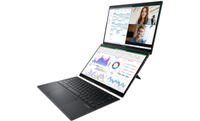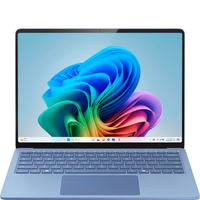Best laptops 2025 tested — January top picks
These are the best laptops we recommend, based on testing dozens of models from Apple, HP, Lenovo, Microsoft and more.
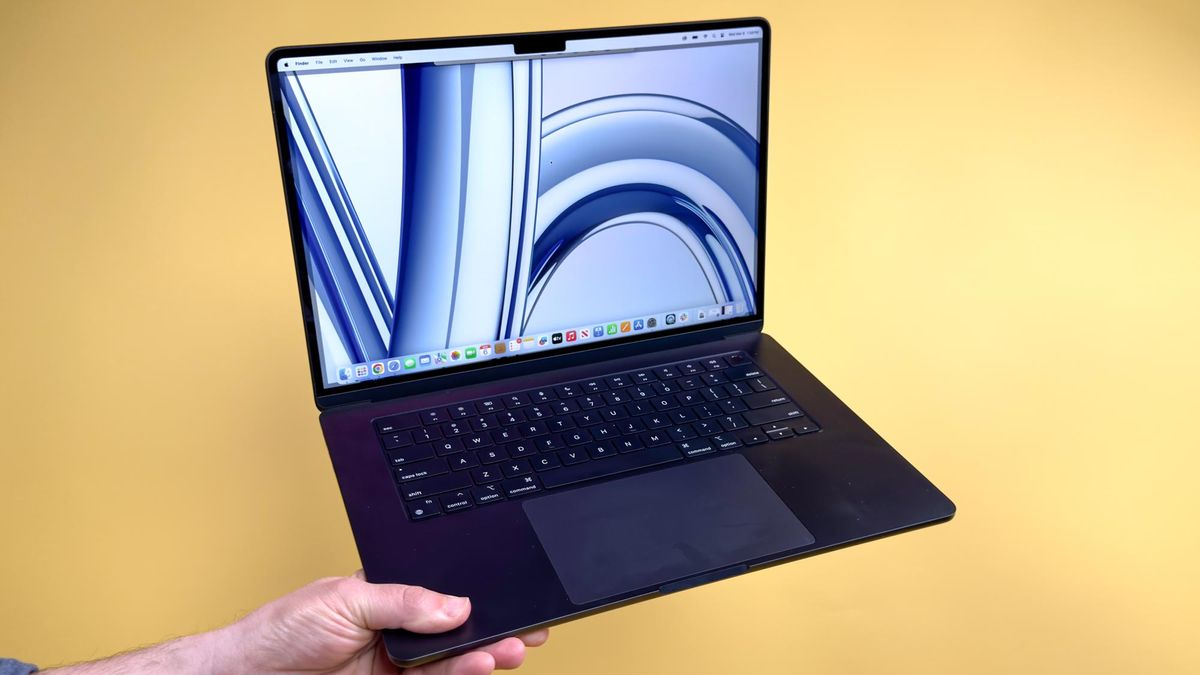
- Quick list
- Best overall
- Best value
- Best for Windows
- Best Copilot laptop
- Best Chromebook
- Most repairable
- Best for gaming
- Best battery life
- Best MacBook Air alternative
- Best 2-in-1
- Best MacBook Pro alternative
- Best MacBook Pro
- Also tested
- Battery life results
- How to choose
- Frequently asked questions
- How we test
I've been reviewing laptops for over a decade, and in this article I'm going to use that expertise to help you find the best laptop for your needs.
My team and I review over 200 laptops a year, so I know which stand out from the pack. I generally recommend the MacBook Air M3 as the best laptop for most folks thanks to its killer combo of price, performance and portability, but if you prefer Windows the Dell XPS 13 is a great alternative while the Acer Aspire Go 15 offers incredible value.
So whether you're shopping for a sleek new ultraportable, a cheap Chromebook, a new gaming laptop or the best MacBook for your needs, you can count on finding at least one great option here!
What is the best laptop for me?
To find the best laptop for your needs, we need to know what you're going to do with it and where you plan to use.
Work & Productivity: If your #1 priority is having a portable PC you can use to answer email, prepare documents and get work done on the go, you want a modern ultraportable that's light, comfy to use and offers great battery life. I generally recommend the MacBook Air M3 (macOS) or the Dell XPS 13 (Windows 11) for this, and you can upgrade to models with bigger screens if you want more room to work.
Gaming: If you plan to spend a lot of time gaming, you want a laptop with a speedy CPU, a discrete graphics card and plenty of RAM. If you plan to play at higher than 60 frames per second, a screen with a high refresh rate is also great. Personally, I recommend the Asus ROG Zephyrus G14 since it satisfies all these requirements.
Creative work: If you plan to do a lot of 3D work, video editing or demanding content creation you will want a laptop that's very similar to a gaming laptop, with a powerful CPU, a discrete GPU and plenty of RAM to handle demanding workloads. A great screen is also nice to have, and I recommend the MacBook Pro (14-inch M4) or the Asus ProArt P16.
Casual use: If you just need a laptop for basic word processing, browsing the web and binge watching your favorite shows, you can save yourself a lot of money with a budget-friendly laptop. I recommend the Acer Aspire Go 15 if you prefer Windows, or the Lenovo Flex 5i Chromebook Plus if you're okay with a Chromebook.
Should I buy a MacBook, Windows laptop or a Chromebook?
Buy a MacBook if you are comfortable using Macs or are already embedded into the Apple ecosystem. While macOS is not as robust as Windows when it comes to gaming, many people find it easy to use and it's tightly integrated with Apple's other products, so your iPhone and AirPods will seamlessly interface with your Mac.
Buy a Windows laptop if you need access to the widest selection of apps, are not tied down to any particular ecosystem, want the best gaming experience and are looking for the broadest selection of laptop designs. Only Windows laptops come with features like touchscreens, high-speed displays or the option to transform into a tablet.
Buy a Chromebook if your work and entertainment needs revolve entirely around a browser. If everything you do is within a Chrome browser, then a Chromebook is the most direct (and cheap) way to get there. Just be aware you'll be limited to that browser window—ChromeOS is a robust operating system, but without Internet access it can't do much.
The quick list
In a hurry? Here's a brief overview of the laptops on this list, along with quick links that let you jump down the page directly to a review of whichever laptop catches your eye.
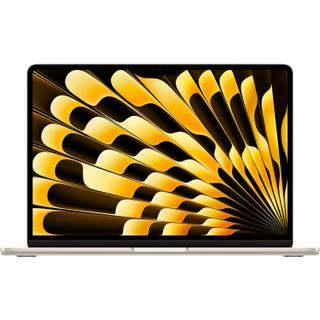
The MacBook Air 13-inch M3 is the laptop we recommend first to most people because it delivers unbeatable value. You get great performance from Apple's M3 chip, a bright display and more than 15 hours of battery life (according to our testing) in an ultraportable package.
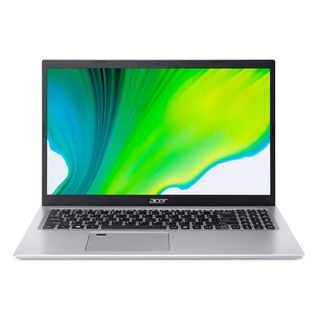
Acer's Aspire Go 15 is the best laptop for the money because it's a decent Windows 11 ultraportable that can be yours for under $500. Sure, it's underpowered and the speakers suck, but I love it because you get a full laptop with a comfy keyboard, decent performance writing and editing and 10+ hours of tested battery life for less than an iPad.
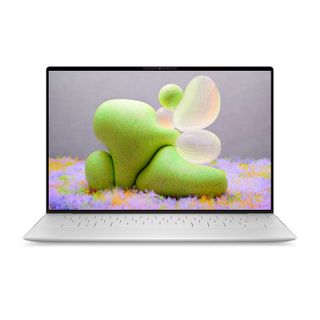
The Dell XPS 13 (2024) is one of the best Windows laptops you can buy now that it has the power of Snapdragon X chips inside, which give this portable powerhouse killer speed and MacBook-beating battery life in our tests. The capacitive keys are controversial, but you can get used to them.
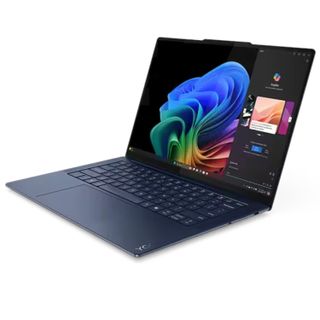
The Lenovo Yoga Slim 7x features blazing-fast performance, incredible battery life and a gorgeous OLED display in an elegant ultraportable chassis. Though its AI features aren’t impressive, it’s an all-around great Snapdragon X Elite Windows laptop that won’t break the bank.
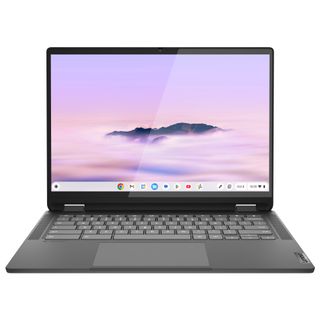
I recommend the Lenovo Flex 5i Chromebook Plus because this 2-in-1 offers a 1200p touchscreen, a good keyboard and plenty of ports, all at an affordable price—without feeling cheap.
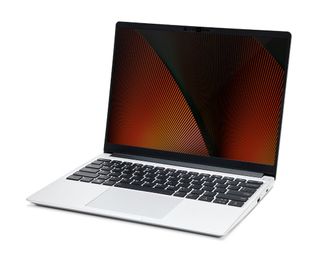
The Framework Laptop is a truly unique ultraportable that's remarkably repairable and upgradeable. It's basically the anti-MacBook, designed to be easy to customize, upgrade and repair while delivering style and performance without compromise.
Read more below
Load the next 6 products...
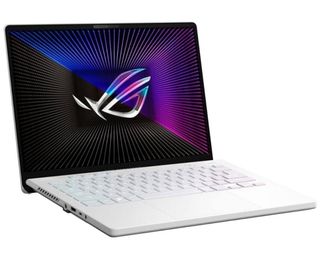
We've long been fans of the Zephyrus G14 because it has the chops to run most games at solid framerates, the efficiency to be used as a work laptop in a pinch, and a slim, compact chassis that's more portable than most gaming laptops.
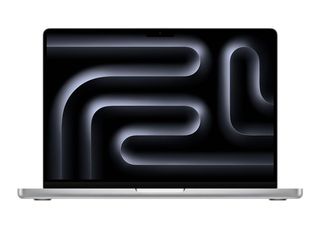
The MacBook Pro M4 Pro lasted nearly 20 hours in our lab battery tests, making it the longest-lasting laptop we've yet tested and the laptop I recommend most to those who prize battery life.
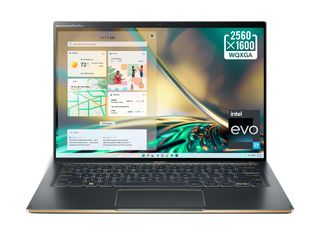
Stylish, lightweight and powerful, the Acer Swift 5 is a truly impressive Windows 11 laptop that rivals the latest MacBooks in terms of size, style and speed. This mid-range productivity notebook delivers compelling value thanks to its power and vivid 14-inch 1600p touchscreen.
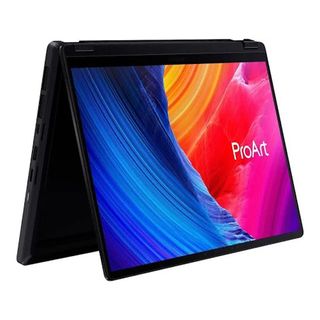
The Asus ProArt PX13 is a mini monster of a 2-in-1 — packing a drop dead gorgeous OLED display, a Copilot+ PC ready screamer of a chip in the AMD Ryzen AI 9 HX 370, and a monstrous RTX 4070 GPU.
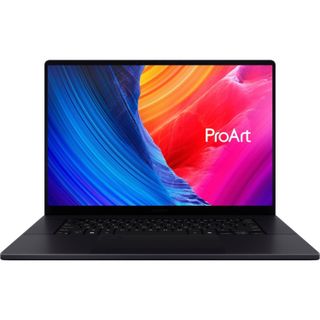
The Asus ProArt P16 is a creative powerhouse of a laptop that doesn’t forget about the ergonomics for making great things. From that gorgeous 4K OLED touchscreen to the DialPad, everything keeps you in your flow.
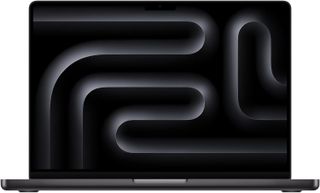
If you want the best blend of price, performance and portability in a MacBook Pro you want the 14-inch M4 MacBook Pro. It lasts nearly as long and is nearly as fast as the 16-inch M4 Pro model, while being cheaper and easier to carry.
The best laptops you can buy today
Why you can trust Tom's Guide
The best laptop overall






Specifications
Reasons to buy
Reasons to avoid
| Test | Notes | How it stacks up |
|---|---|---|
| Battery life | 15:13 tested battery life | ★★★★★ |
| Performance | Speedy, good for light work | ★★★★☆ |
| Design | Thin and elegant, light on ports | ★★★★☆ |
| Display | Bright, colorful 13.6-inch panel | ★★★★☆ |
What you need to know
The MacBook Air M3 is an excellent all-rounder that feels truly worthy of the Air name. Though it's virtually indistinguishable from the excellent MacBook Air 13-inch M2 that previously topped this list, the M3 variant is hard to dismiss.
The MacBook Air M3 (from $1,099) is a breath of fresh you-know-what, and that’s because Apple paired that speedy M3 chip with the same ultraportable design of its predecessor. It's a potent blend of performance and portability, one we recommend as one of the best laptops for getting work done on the go for most folks.
Buy it if
✅ You need a long-lasting laptop: The MacBook Air M3 lasted more than 15 hours in our battery test, which is longer than its predecessors.
✅ You want a small, fast MacBook: The M3 chip inside this MacBook Air gives it more than enough power for multitasking, and it pairs well with the long battery life and light weight.
Don't buy it if
❌ You want to play games: While this laptop does a stellar job of running games optimized for Apple silicon, non-supported games have trouble running at acceptable frame rates.
❌ You own a MacBook Air 13-inch M2: The MacBook Air M3 is certainly powerful, but only slightly faster than M2.
The bottom line
💻 The MacBook Air M3 is a bit pricey, but it justifies the premium with an unbeatable combination of performance, battery life, display quality and portability.
The deep dive
Read the deep dive ▼
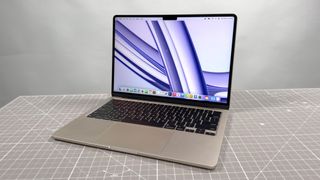
Design
The MacBook Air M3 is so thin it could easily be mistaken for an iPad when closed (especially if the Apple logo is facing out). That’s how slim this notebook is. Measuring just 0.44 inches thick with the lid open, an everyday Bic pen looks chunky next to this machine.
Don't expect to get much in the way of ports, however. As before, you get just a pair of Thunderbolt 4/USB 4 ports along the left edge, alongside a MagSafe power adapter. At least you also get a headphone jack.
Display
The 13.6-inch display offers a 2,560 x 1,664-pixel resolution and gets nice and bright in person, so it's a pleasant place to watch videos, write emails, edit photos and whatever else you want to do.
The MacBook Air M3 did well in our display tests, too. When we tested it with our light meter we found it delivers an average brightness of 476 nits, peaking around 496 when viewing HDR videos. That’s brighter than the Dell XPS 13 OLED’s 357-nit average.
Performance
On Geekbench 6, which measures overall performance, the MacBook Air M2 hit 3,082 on the single-core CPU test and 12,087 on multi-core. That’s faster than both its predecessors, though the performance gulf is widest between the old Air M1 and Air M3. For more details, check out our in-depth MacBook Air M3 benchmark results!
Battery life
The MacBook Air M3 is one of the longest-lasting laptops for the money. On the Tom’s Guide battery test, the new Air averaged 15 hours and 13 minutes, which is better than average.
More like this
1. The best MacBook: See all models compared
2. The best laptops for battery life
3. The best 2-in-1 laptops, for when you can't decide between a laptop and a tablet
Read the full review: MacBook Air 13-inch M3
The best value laptop






Specifications
Reasons to buy
Reasons to avoid
| Test | Notes | How it stacks up |
|---|---|---|
| Battery life | 10 hours of tested battery life | ★★★★☆ |
| Performance | Underpowered CPU causes this laptop to bog down easily | ★☆☆☆☆ |
| Display | 1080p LCD display is good enough but washed-out and a bit dim | ★★★☆☆ |
| Design | Thicker and heftier than modern ultraportables, but still plenty portable and attractive | ★★★☆☆ |
What you need to know
The Acer Aspire Go 15 is a cheap laptop in good and bad ways. For $299 you get a thick-set 15-inch ultraportable with a spacious keyboard, plenty of ports and 10+ hours of tested battery life.
Of course, you have to make some trade-offs when you buy this laptop. The speakers aren't very good, the low-res webcam makes you look washed-out and performance in anything but writing and browsing the web is pretty disappointing.
But if you can live with those compromises you get a pretty useful laptop for not very much money. It's the kind of thing I'd recommend a parent give a child as their first laptop, as it's great for surfing the web and doing homework. Remote learning, office work and research are all easy to do on this affordable 15-incher, but don't expect to play games or run apps more complicated than Minecraft.
Design: The Acer Aspire Go 15 is a thick-set laptop that measures roughly 14.29 x 9.44 x 0.74 inches and weighs 3.86 pounds. That makes it a bit chunkier and heavier than your average 15-inch ultraportable, but it's still easy enough to carry around the house or toss into a backpack on the way to school.
I actually find the plain silver chassis to be kind of attractive since it's so simple and straightforward, but you can always spruce it up with stickers if you want some flair. Along the edges you'll find a decent port array, including two USB-A ports and a USB-C port, an HDMI out and a 3.5mm headphone jack—which is nice to have given the way headphone ports have become an increasingly rare commodity on modern laptops.
Display: If you're a display snob, you might be a bit unhappy with the Acer Aspire Go 15's 15.6-inch LCD screen. The 60Hz 1080p display is plenty good enough for browsing the web or reading, but videos and games look a bit washed-out and dim.
But as long as you're not planning to use this thing outside in direct sunlight all the time, it's more than good enough for basic work and play.
Performance: The big weak point of this laptop is its performance. The Intel Core i3-N305 CPU and 8GB of RAM in our review unit is fine as long as you're just running a web browser with some open tabs and maybe an app like Spotify in the background, but forget about running demanding apps without serious slowdown.
Not only can you not do much in the way of serious photo/video editing on this machine, but you can't play many games and you definitely won't be able to run any onboard AI apps. Heck, even opening more than 10+ tabs in Chrome can make this laptop feel noticeably slower.
Battery life: One nice thing about this laptop's underpowered CPU is the fact that it doesn't eat up much battery power when you're out and about.
I know because this laptop lasted just over 10 hours (10:15) in our in-house battery test, which means you can safely carry it through a day of work or school without needing to lug the charger with you. You'll have to keep the screen dim and be sparing with the apps, but 10+hours of tested battery life is pretty good for a Windows laptop.
Read the full review: Acer Aspire Go 15
What you need to know
The Acer Aspire Go 15 is a cheap laptop in good and bad ways. For $299 you get a thick-set 15-inch ultraportable with a spacious keyboard, plenty of ports and 10+ hours of tested battery life.
Of course, you have to make some trade-offs when you buy this laptop. The speakers aren't very good, the low-res webcam makes you look washed-out and performance in anything but writing and browsing the web is pretty disappointing.
But if you can live with those compromises you get a pretty useful laptop for not very much money. It's the kind of thing I'd recommend a parent give a child as their first laptop, as it's great for surfing the web and doing homework. Remote learning, office work and research are all easy to do on this affordable 15-incher, but don't expect to play games or run apps more complicated than Minecraft.
Buy it if
✅You need a Windows 11 laptop under $500: The Acer Aspire Go 15 is one of the best laptops under $500 you can get, in my opinion, because it delivers all the utility of a Windows ultraportable for $299. If you need a cheap laptop for school or getting basic work done, this is a great choice.
✅ You need a versatile productivity machine: Acer's Aspire Go 15 can feel sluggish and can't run demanding games or apps, but what it can do is handle web surfing, writing, schoolwork and emails. The keyboard is surprisingly spacious and comfy and you get a versatile array of ports to boot, making this cheap laptop surprisingly good for school and office work.
Don't buy it if
❌ You can't stand sluggish PCs: The Acer Aspire Go 15 can help you get work done, but it won't do it quickly. The weak Intel Core i3-N305 CPU in our review unit chugged if I opened too many Chrome tabs or apps at once, and forget about playing any but the simplest of PC games.
❌You want to look good on video calls: The cheap 720p webcam built into the Acer Aspire Go 15 is just not very good. It's serviceable if you need to have a chat with colleagues or family, but you won't look your best.
The bottom line
💻 The Acer Aspire Go 15 is a cheap Windows laptop, in both good and bad ways. Luckily, the parts of it which feel cheap in a bad way aren't dealbreakers unless you really can't stand a slow laptop. But if you can make peace with its underpowered performance, the Go 15 will reward you with a sturdy, versatile Windows experience that can last 10+ hours on a full battery, according to our testing.
The deep dive
Read the deep dive ▼
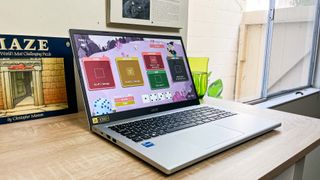
Design
The Acer Aspire Go 15 is a thick-set laptop that measures roughly 14.29 x 9.44 x 0.74 inches and weighs 3.86 pounds. That makes it a bit chunkier and heavier than your average 15-inch ultraportable, but it's still easy enough to carry around the house or toss into a backpack on the way to school.
I actually find the plain silver chassis to be kind of attractive since it's so simple and straightforward, but you can always spruce it up with stickers if you want some flair. Along the edges you'll find a decent port array, including two USB-A ports and a USB-C port, an HDMI out and a 3.5mm headphone jack—which is nice to have given the way headphone ports have become an increasingly rare commodity on modern laptops.
Display
If you're a display snob, you might be a bit unhappy with the Acer Aspire Go 15's 15.6-inch LCD screen. The 60Hz 1080p display is plenty good enough for browsing the web or reading, but videos and games look a bit washed-out and dim.
But as long as you're not planning to use this thing outside in direct sunlight all the time, it's more than good enough for basic work and play.
Performance
The big weak point of this laptop is its performance. The Intel Core i3-N305 CPU and 8GB of RAM in our review unit is fine as long as you're just running a web browser with some open tabs and maybe an app like Spotify in the background, but forget about running demanding apps without serious slowdown.
Not only can you not do much in the way of serious photo/video editing on this machine, but you can't play many games and you definitely won't be able to run any onboard AI apps. Heck, even opening more than 10+ tabs in Chrome can make this laptop feel noticeably slower.
Battery life
One nice thing about this laptop's underpowered CPU is the fact that it doesn't eat up much battery power when you're out and about.
I know because this laptop lasted just over 10 hours (10:15) in our in-house battery test, which means you can safely carry it through a day of work or school without needing to lug the charger with you. You'll have to keep the screen dim and be sparing with the apps, but 10+hours of tested battery life is pretty good for a Windows laptop.
More like this
1. Best budget laptops
2. I review PCs for a living and this $300 laptop does more than an iPad for less
Read the full review: Acer Aspire Go 15
The best Windows laptop







Specifications
Reasons to buy
Reasons to avoid
| Test | Notes | How it stacks up |
|---|---|---|
| Battery life | 19:41 tested battery life | ★★★★★ |
| Performance | The latest Snapdragon CPUs give it plenty of speed | ★★★★★ |
| Display | OLED would be nice, but at least this screen gets bright | ★★★★☆ |
| Design | Easy to carry but needs more ports | ★★★☆☆ |
What you need to know
The Dell XPS 13 hits a sweet spot between portability, price and performance in a Windows laptop.
We've long loved the excellent compromise between portability and screen size that is the XPS 13, and the 2024 model maintains that killer look while upgrading to a killer Snapdragon X CPU that delivers outstanding battery life.
While the row of capacitive touch function keys and the invisible touchpad are controversial design choices that take some getting used to, those that do will be rewarded with one of the best Windows laptops you can buy. The 2024 Dell XPS 13 may only have a pair of USB-C ports and little else in the port department, but if you just need a fast, lightweight Windows 11 machine for getting things done on the go, this is a great choice.
Buy it if
✅ You want a great Windows laptop: There are many great Windows laptops out there, but the Dell XPS 13 shines with its winning combo of svelte design, performance and portability.
✅You want great battery life: The Snapdragon X chip helped our review unit last nearly 20 hours (19:41) in our battery test, which is incredible for a Windows laptop. If you want all-day battery life, get an XPS with Snapdragon inside.
✅ You don't use a lot of peripherals: The XPS 13 only offers two USB-C ports, one of which you need to use when charging the laptop, so it's not great for folks who like to plug in a lot of devices.
Don't buy it if
❌ You like physical keys: The Dell XPS 13 has no physical function keys, instead sporting a touch-sensitive bar with light-up capacitive touch keys in its place. So if you hate capacitive touch keys, don't buy this laptop.
❌ Ports are important: The XPS 13 sports 2 USB-C ports, and that's it. You don't even get a headphone jack (though it does come with an adapter that lets you plug some into a USB port), so if you value ports don't buy this laptop.
The bottom line
💻 The Dell XPS 13 is an excellent Windows laptop that's perfect for work thanks to its light weight, speedy performance and incredible battery life.
The deep dive
Read the deep dive ▼
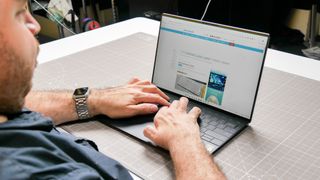
Design
At 11.6 x 7.8 x 0.6 inches inches and roughly 2.6 pounds heavy, the Dell XPS 13 is pretty portable and easy to carry. Plus, it looks great on a desk. You can throw it in your backpack and carry it through a day of school or work, without having to worry about feeling the extra load.
Display
The 13.4-inch display on the XPS 15 looks great and almost appears to hover in the the air thanks to the thin bezels of its InfinityEdge display. It's not especially lush but it does get bright, which is nice when working outside in the sun.
Performance
The Dell XPS 13 is a capable machine, and our review unit was more than speedy enough at time of review thanks to its Snapdragon X Elite CPU, 16GB of RAM and 512GB SSD.
However, be aware that without the option to put a discrete graphics card in this laptop it will never be great for gaming on anything other than cloud gaming services.
Battery life
Our Dell XPS 13 review unit lasted 19 hours and 41 minutes in our battery test, which is amazing battery life. You can carry this laptop through a whole day of work or school confident that you won't have to bring a charger.
However, it is much better than many Windows laptops,
Read the full review: Dell XPS 13 (2024) review
The best Copilot laptop







Specifications
Reasons to buy
Reasons to avoid
| Test | Notes | How it stacks up |
|---|---|---|
| Battery life | 14:14 tested battery life | ★★★★★ |
| Performance | The Snapdragon X Elite chip delivers stellar performance | ★★★★★ |
| Display | Its 14.5-inch (2,944 x 1,840) OLED display is one of the big selling points | ★★★★★ |
| Design | This ultraportable laptop is light and thin enough to carry around all day | ★★★★★ |
What you need to know
The Lenovo Yoga Slim 7x is a Windows 11 laptop built for portability and efficiency.
Thanks to its Snapdragon X Elite chip, you'll get more than all-day battery life and enough performance to power through your regular workload. The OLED panel is a marvel to behold, and its ultraportable design makes it easy to travel with. For $1,199, it offers an excellent value all around.
Buy it if
✅ You want a great Copilot+ laptop: Copilot+ PCs with Snapdragon X Elite chips are great, but the Lenovo Yoga Slim 7x delivers a great combination of portability, performance and battery life.
✅You want an OLED display: The Lenovo Yoga Slim 7x's OLED display is one of its strongest attributes. It delivers vibrant colors and deep contrasts at a sharp 2,944 x 1,840 resolution.
✅ You want dependable battery life: The Yoga Slim 7x lasted for 14 hours on our battery life test, which is well more than you'll need for a full workday — with enough left over to stream some videos.
Don't buy it if
❌ You expect useful AI features: This is an issue with all Copilot+ PCs at the moment, but the advertised AI features this laptop supports aren't fully realized yet. As such, don't expect this laptop to deliver in that regard.
❌ You want a headphone jack: If you want to listen to music or videos without bothering your neighbors then you'll need to use a pair of wireless headphones since this laptop doesn't have a headphone jack.
The bottom line
💻 The Lenovo Yoga Slim 7x is arguably the best Copilot+ PC thanks to its ultraportable design, fast performance, gorgeous OLED panel and phenomenal battery life. Best of all, it won't break the bank.
The deep dive
Read the deep dive ▼
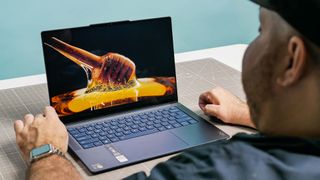
Design
At 12.8 x 8.8 x 0.5 inches and weighing 2.8 pounds, this svelte notebook is almost as thin and light as the 13-inch MacBook Air. And thanks to its sturdy aluminum chassis and tasteful Cosmic Blue color, it looks just as good as Apple’s laptop.
Display
The OLED display is a big selling point of the Lenovo Yoga Slim 7x because it makes everything you do on it look lovely. This display pumps out inky blacks, eye-scorching whites, and super-saturated colors. In addition, the sharp 2,944 x 1,840 resolution means everything you’re looking at is nice and clear.
Performance
The Yoga Slim 7x can easily handle most everyday workloads thanks to its fast Snapdragon X Elite processor and 16GB of RAM (upgradeable to 32GB). It also runs cool and quiet. In our battery test, it matched or exceeded its Apple M-series and Intel Core Ultra-driven competitors.
Battery life
In our battery test, the Lenovo Yoga Slim 7x averaged 14 hours and 14 minutes, which is astonishing for a Windows laptop. This is ultimately due to the Snapdragon X Elite chip inside, which helps Windows laptops achieve MacBook levels of battery life.
Read the full review: Lenovo Yoga Slim 7x
The best Chromebook






Specifications
Reasons to buy
Reasons to avoid
| Test | Results | How it stacks up |
|---|---|---|
| Battery life | 7:36 tested battery life | ★★★☆☆ |
| Performance | Not good for much besides browsing and light work | ★★☆☆☆ |
| Display | 14-inch 1200p touchscreen is nice and bright | ★★★★☆ |
| Design | Plenty of ports, a comfy keyboard and low-key unassuming design make this a great work laptop | ★★★☆☆ |
What you need to know
The Lenovo Flex 5i Chromebook Plus is the Chromebook I recommend most often to folks shopping for one because it does everything a Chromebook can do pretty well, from basic office work to watching videos and streaming games.
Buy it if
✅ You want a Chromebook that turns into a tablet: The Lenovo Flex 5i Chromebook Plus can fold 360 degrees to function like a hefty Chrome tablet. It's harder to type on, but more comfortable to hold in some situations and also easier to tent when watching movies.
✅You expect to type a lot: Keyboard quality can be hit or miss on Chromebooks, especially 2-in-1s, so I'm pleased to report I really enjoyed my time typing on the Lenovo Flex 5i Chromebook Plus thanks to its spacious, well-designed keyboard.
Don't buy it if
❌ You need oodles of battery life: The Lenovo Flex 5i Chromebook Plus lasted under 8 hours (7:36) in our battery test, so I can't recommend it if you need a laptop with all-day battery life. However, if you can bear to lug the charger along it at least charges quickly.
❌ You need great performance: Chromebooks are rarely very powerful, and this one isn't amazing in that department. While it's faster than many competing Chromebooks, the Lenovo Flex 5i Chromebook Plus is a poor choice if you plan to do demanding work like audio/video editing, production work, game development or the like.
The bottom line
💻 The Lenovo Flex 5i Chromebook Plus is a great value, giving you a lovely 1200p 16:10 touchscreen, a comfy keyboard and enough ports for all your accessories in a a very affordable package. It's not the best laptop on the market, but it is the best Chromebook right now.
The deep dive
Read the deep dive ▼
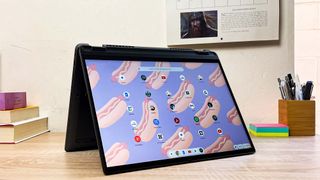
Design
The Lenovo Flex 5i Chromebook Plus is an affordable Chromebook that doesn't look like it, and while it's not the lightest around at 3.57 pounds the 12.4 x 9 x 0.8 inch chassis is svelte enough to slip into a backpack with ease. It's well-designed for working on the go too, thanks to its bright 14-inch touchscreen and comfy keyboard.
Display
The Lenovo Flex 5i Chromebook Plus sports a 14-inch (1920x1200) IPS touchscreen that looks awfully bright indoors or in shade, though in bright sunlight I struggled to make out details when streaming movies.
The display rotates 360 degrees around the laptop, too, allowing you to tent it up on a table for watching movies or hold it in your hands like an oversized Chrome tablet.
Performance
My Lenovo Flex 5i Chromebook Plus review unit had an Intel Core i3-1315U inside plus 8GB of LPDDR4x RAM, and that's enough to make browsing the web and doing basic office tasks feel plenty fast enough.
However, this 2-in-1 will begin to slow down and struggle a bit when you're running a lot of apps at once and then do something wild like launch an Android game. You can multitask with it just fine, but when performance is important you'll want to close everything you don't need running.
Battery life
The Lenovo Flex 5i Chromebook Plus lasted just under 8 hours in our Tom's Guide battery test, which times how long the laptop can endlessly surf the web (with the screen set to a relatively dim 150 nits of brightness) until it runs out of juice.
That's decent enough, but it's a bit underwhelming that you can't count on this Chromebook to last you through a full 8-hour day of school or work without running out of juice.
So while this remains a great Chromebook for basic work and play, if you plan to be using it on the go for longer than 6-7 hours I recommend carrying the charger with you.
More like this
1. Best Chromebooks
2. Best Chromebooks for kids
3. I review Chromebooks for a living, and I install these 5 apps every time
Read the full review: Lenovo Flex 5i Chromebook Plus
The best laptop to repair and upgrade






Specifications
Reasons to buy
Reasons to avoid
| Test | Results | How it stacks up |
|---|---|---|
| Battery life | 11:38 tested battery life | ★★★★☆ |
| Performance | Speedy enough for work and light gaming | ★★★☆☆ |
| Display | Functional, sharp display | ★★★☆☆ |
| Design | Elegant, unassuming chassis belies useful complexity | ★★★★☆ |
What you need to know
When it came out we called the Framework Laptop the Anti-MacBook because it's everything Apple doesn't do in laptops: Repairable, upgradable and respectful of your rights as an owner.
I was initially excited about those promises but dubious the company could deliver on them without some glaring sacrifices. But now that I’ve used one myself, I’m happy to report the Framework Laptop is as good as advertised. With its intentionally easy-to-repair design (you can pop pieces off this laptop and get at the innards in minutes, with no tools besides the spudger it comes with) and super cool swappable Expansion Card ports, the Framework Laptop 13 is a versatile ultraportable that's one of the best laptops you can buy if you care about your right to repair and tinker with your devices.
Buy it if
✅ You care about your right to repair: I've never seen a laptop that's easier to open up, fiddle around with and put back together. No other laptop on the market can match the Framework in this regard, so if you care about being able to repair and upgrade your laptop, this is the one for you.
✅ You're plagued by port envy: On most laptops, the ports it comes with are all you get. The Framework is different: you can change what ports it sports by buying hot-swappable Expansion Cards that you plug into 4 slots on the bottom of the laptop, and each can have one port on it. So you can swap out 2 USB-C and 2 USB-A ports for 1 USB-C, 1 USB-A, a DisplayPort out and an Ethernet jack, for example.
✅ You like a tall screen: The 3:2 display ratio of the Framework's screen feels a bit taller than the displays found on most laptops, and it's great for working with "tall" things like long documents, emails, coding projects and more.
Don't buy it if
❌ You're scared by pieces of your laptop coming off: The Framework is well-designed and sturdy, but because it's designed to be taken apart you may occasionally find yourself accidentally doing something like popping the bezel off the screen. This is a feature, not a problem, but it can unnerve new owners.
❌ You don't want to pay extra for ports: The Framework offers unrivaled port versatility thanks to its Expansion Card system, but it does require buying a handful of Cards for all the ports and other options you want, some of which could be easily lost or misplaced.
The bottom line
💻 The Framework Laptop is a remarkable piece of tech. It's a great laptop for getting work done, but more than that it's a statement of purpose, a clear example that every other laptop maker could be building and selling us more repairable, sustainable laptops if they cared to as much as Framework does. Its a fantastic investment if you care about your right to repair and upgrade your own laptop.
The deep dive
Read the deep dive ▼
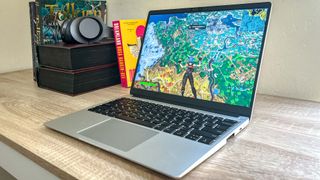
Design
The Framework sports a simple silver aluminum chassis that blends right in with all the other laptops in the coffee shop, until you spot the Framework gear logo on the lid.
At 11.67 x 9 x 0.62 inches in size and just 2.8 pounds, this DIY ultraportable is just as thin and even a hair lighter than Apple's MacBook Air, an especially incredible feat when you realize the Framework achieves that 0.62-inch thinness while still being modular and full of easy to access, mostly user-replaceable parts that, unlike a MacBook, aren't needlessly soldered to the mainboard in a way that makes repairing or upgrading a MacBook nearly impossible.
Display
The Framework's 13.5-inch display is sharp and functional, and its relatively7 rare 2,256 x 1,504 resolution (a byproduct of the 3:2 aspect ratio) is well-suited for viewing webpages and text. It also gets plenty bright in person, though you'll probably be frustrated if you try using it outdoors in direct sun.
Performance
While the Framework I tested performed well under pressure, the cooling fans are awfully loud and sometimes kick on even when doing light work like browsing the web. It also underperformed a bit in our performance benchmarks compared to a lot of its contemporaries. Our unit also fell a bit behind its contemporaries in our performance tests, so while it's great for work and some light gaming I wouldn't try taxing it with anything more serious.
Battery life
The Framework’s battery is good enough to get you through a day of work without needing to pack a charger, which is great to see in a productivity laptop. The Framework lasted 11 hours and 38 minutes in our battery test, which as you'll see from the chart of test results is quite good compared to some other laptops on this page.
Read the full review: Framework Laptop 13 (2023)
The best gaming laptop







Specifications
Reasons to buy
Reasons to avoid
| Test | Results | How it stacks up |
|---|---|---|
| Battery life | 10:14 tested (non-gaming) battery life | ★★★★☆ |
| Performance | Great for work and gaming | ★★★★★ |
| Display | Screen looks good and accommodates high-framerate gaming | ★★★★☆ |
| Design | Slim, unassuming design blends in at home or at work | ★★★★☆ |
What you need to know
The Asus ROG Zephyrus G14 is one of the best gaming laptops on the market for most people because it's powerful, easy to carry and offers best-in-class battery life (for a gaming laptop). The newer models offer a better, brighter screen than earlier models, with good speakers and an AMD CPU/GPU combo that delivers solid gaming performance. This model also has a webcam built into the top bezel of the display, a convenience for video calls that earlier models lacked.
However, in our testing lab we found the Zephyrus G14 can't always deliver better performance than similarly-priced gaming laptops, and the webcam isn't very good. Still, you'd have a hard time finding a better gaming laptop (that can also double as a work or school laptop) for this price.
Buy it if
✅ You want a gaming laptop you can take to class: You can find gaming laptops with lower price tags, bigger screens or more powerful innards, but you won't find many with better battery life, or that look as good on a desk. The Zephyrus G14 stands apart from the crowd by being powerful to play the latest games, yet performant and low-profile enough to double as a work laptop.
✅ You want an all-AMD gaming machine: PC diehards have strong feelings about Intel vs. AMD vs. Nvidia components. If you prefer an all-AMD laptop, the Zephyrus G14 can deliver that, and the much-ballyhooed efficiency of AMD components may have something to do with this laptop's remarkable battery life.
Don't buy it if
❌ You want more than 14 inches: The 14-inch (2,560 x 1,600 pixels) 120Hz display on the Zephyrus G14 is great, but it's a little small to really enjoy playing games to full effect. You could always hook the laptop up to one of the best gaming monitors, but if you want a larger canvas for gaming on the go you should look elsewhere.
❌ Webcam quality matters: The 720p webcam in the latest ROG Zephyrus G14 leaves a lot to be desired, and if you use it for streaming you'll hardly look your best. That said, earlier Zephyrus G14 models didn't even have webcams, so at least you get one this time around.
The bottom line
💻 The Asus ROG Zephyrus G14 is a great gaming laptop, delivering a potent blend of performance, portability and power efficiency. The bright 16:10 120Hz display makes games and movies look great, while the speakers sound good enough that you won't feel compelled to use headphones.
The deep dive
Read the deep dive ▼
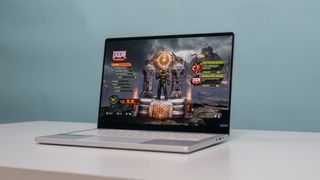
Design
The Zephyrus G14 measures 12.28 x 8.94 x 0.77 inches, weighs 3.79 pounds and looks good in Asus’ bright Moonlight White color scheme. The rounded corners and tapered edges balance out the sharp diagonal vents scattered across the chassis, and the optional and eye-catching AniMe Matrix mini-LED display on the back of the lid is a $600 cosmetic upgrade that will definitely turn heads.
Display
The 14-inch WQXGA (2,560 x 1,600 pixels) display on the Asus ROG Zephyrus G14 looks great, and with its 16:10 aspect ratio I had no trouble juggling a lot of open windows on the desktop. The 120Hz refresh rate, 3ms response time and support for Dolby Vision HDR ensure the display is well-suited to making games and movies look their best.
Performance
Gaming performance is what matters in a laptop like this, and the Zephyrus G14 delivers if you configure it right. Our well-equipped review unit to hit 30-40 frames per second in Cyberpunk 2077 on max settings. However, that was with the help of AMD's FidelityFX Super Resolution upscaling tech. In general, this laptop can run the best PC games quite well, and it has no trouble with basic productivity tasks.
Battery life
The Asus Zephyrus G14 lasted roughly 10 hours and 14 minutes in our Tom's Guide battery test, and barely over an hour when gaming. That's great web browsing time for a gaming laptop, so this is a great choice if you want a gaming machine that can also last through a day of classes.
Read the full review: Asus ROG Zephyrus G14
The longest-lasting laptop







Specifications
Reasons to buy
Reasons to avoid
| Test | Results | How it stacks up |
|---|---|---|
| Battery life | 20:46 hours of tested battery life | ★★★★★ |
| Performance | Speedy at prosumer tasks | ★★★★☆ |
| Display | Gorgeous mini-LED | ★★★★★ |
| Design | Premium, durable design | ★★★★★ |
What you need to know
The new MacBook Pro 16-inch (M4 Pro, 2024) occupies the middle spot between the more affordable 14-inch MacBook Pro M4 and the more powerful (and expensive) MacBook Pro 16-inch M4 Max. It’s a laptop for those who want a 16-inch MacBook Pro but don’t want to spend an extra $1,000 for an M4 Max model.
This laptop sports the same practical design as modern MacBooks, alongside fast M4 Pro-driven performance and nearly 21 hours of battery life. As before, you get a gorgeous Liquid Retina XDR display, full-height function keys, amazing speakers and plenty of ports.
Buy it if
✅ You want a fast MacBook: While you shouldn’t expect this to match the video-crunching power of the beefier M4 Max Max MacBook Pro, the M4 Pro-equipped 16-inch MacBook Pro is one of the fastest laptops on the block.
✅ Battery life is key: The 16-inch MacBook Pro with M4 Pro set a new high-water mark for battery life when we tested it, lasting for nearly 21 hours in our battery endurance tests. That's one of the longest-lived laptops we've ever tested.
✅ You don’t want to pay for an M4 Max model: If you want a 16-inch MacBook Pro but don’t want to spend an extra $1,000 for an M4 Max model, this M4 Pro-driven laptop is the best bet as it still offers fantastic performance and epic battery life.
Don't buy it if
❌ You’re on a budget: While this laptop is cheaper than an M4 Max MacBook Pro, it’s still an expensive device. If you’re on a budget and mainly want a notebook for work or watching videos, the $1,299 15-inch MacBook Air M2 is a better choice.
❌ You need more power: Conversely, if you’re a professional content creator or gamer who needs as much processing power as possible, you’re better off with an M4 Max MacBook Pro.
❌ Notches bug you: There's a little notch in the center of the top bezel where the camera housing sits, and while most of us get used to it some folks really hate the way it looks. If that's you, consider another laptop.
The bottom line
💻 The 16-inch MacBook Pro with M4 Pro delivers some of the best battery life of any laptop we've tested to date, along with great performance, a beautiful display and a refined design.
The deep dive
Read the deep dive ▼
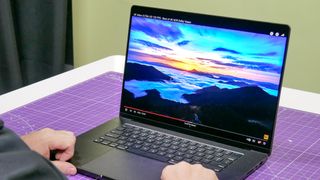
Design
The new MacBook Pro features the same unibody aluminum design as recent MacBook Pro and MacBook Air laptops. It has a utilitarian frame that comes with a somewhat distracting display notch. The overall look and feel signal it as a premium machine.
Along the left side of the laptop, you'll find the MagSafe charging port, two Thunderbolt 5 / USB 4 ports and a 3.5mm headphone jack. Over on the right you’ll find the HDMI port and SD Card slot.
Display
The MacBook Pro M4 Pro’s 16-inch, mini-LED Liquid Retina XDR display is still one of the best you’ll find on any laptop, even if it’s not as rich as an OLED panel. Brightness for SDR (Standard Dynamic Range) hit 564 nits brightness in our testing, and HDR brightness tops out at 1,116 nits across 100% of the display.
Performance
This MacBook Pro’s M4 Pro chip is a great slice of Apple silicon, which is why this is one of the most powerful laptops on this list if you care about demanding work like photo/video editing or game development.
In our testing, the MacBook Pro 16-inch M4 Pro performed better on the Geekbench 6 CPU test than its M3 Pro-powered counterpart. It can even run games like Resident Evil 4 Remake at a smooth 100 frames a second with bells and whistles like hardware-accelerated ray tracing.
Battery life
In our battery testing, the 16-inch M4 Pro MacBook Pro lasted for 20 hours and 46 minutes. That makes it the longest-lasting consumer-grade laptop we’ve ever tested at Tom’s Guide. In short, the M4 Pro MacBook Pro can easily last you through a full day of work and beyond. If you need great battery life, this is the longest-lasting laptop on this list.
Read the full review: MacBook Pro 14-inch (M4 Pro, 2024)
The best MacBook Air alternative





Specifications
Reasons to buy
Reasons to avoid
| Test | Notes | How it stacks up |
|---|---|---|
| Battery life | 11:25 tested battery life | ★★★★☆ |
| Performance | Speedy but not great for gaming | ★★★★☆ |
| Display | Tall, beautiful screen | ★★★★☆ |
| Design | Elegant, striking design with plenty of ports | ★★★★☆ |
What you need to know
The Acer Swift 5 is a svelte Windows laptop sporting a slick design, a gorgeous 1600p display and a speedy enough 12th-gen Intel chip onboard to get you through a day of work. It’s also cheaper than its chief rivals when comparably equipped.
While this laptop has some flaws, it's a great machine that delivers a lot of value for its sub-$2k price tag.
Buy it if
✅ You love 1600p resolution: The Swift 5 is a great all-rounder, but one thing that sets it apart is its unique 2,560 x 1,600 display. That's effectively the 16:10 equivalent to 1440p, and if you love the idea of a taller, higher-res display on your Windows laptop this is one of the few to deliver it.
✅ You want a MacBook Air M2 competitor for less: Acer gave the 2022 Swift 5 a smart redesign and a component upgrade that helps it rival premium ultraportables like Apple's MacBook Air or Dell's XPS 13, but the Swift 5 costs a bit less than either.
Don't buy it if
❌ You want to play a lot of games: The beautiful 1600p display makes what you do on the Swift 5 look great, but you won't be doing a lot of high-intensity gaming with just an Intel CPU and no discrete GPU.
❌ You hate bloatware: Almost every new PC comes with some software pre-installed, but Acer really takes it up a notch. You’ll find unnecessary apps like Booking.com, Simple Mahjong, Planet9 Link, Aura Privacy, ExpressVPN, Forge of Empires, and other programs that aren’t part of a vanilla Windows 11 install on a new Swift 5, which is a hassle to clear out.
The bottom line
💻 The Acer Swift 5, with its great 1600p display, fast SSD, a great design — and a good price — represents a very strong value compared to similarly-specced competitors. Those looking for a productivity notebook will especially appreciate its 16:10 display, which makes it easier to view documents and spreadsheets. However, it's not an ideal gaming platform, and its battery life could be better.
The deep dive
Read the deep dive ▼
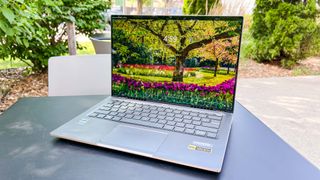
Design
While older Swift 5 laptops looked pretty generic, the 2022 model has a beautiful design with eye-catching edges decked out in a double-anodized gold treatment.
Measuring 12.2 x 8.4 x 0.59 inches and weighing just 2.65 pounds, the Acer Swift 5 is thicker than Apple's MacBook Air but also a hair lighter. The Acer Swift 5 feels sturdy despite its light weight thanks to its resilient aluminum chassis, and our review unit had a beautiful diamond pattern traced on it in gold lines that are as thin as a human hair, according to Acer.
Display
The Acer Swift 5’s 14-inch panel looks beautiful, and its WQXGA resolution (2560x1600, or 1600p) ensures it can deliver more pixels on-screen than more traditional 1080p or 1440p laptop displays.
The display offers a 16:10 aspect ratio, and in our testing the big, wide screen was easy to digest at a glance and made the games and movies we watched on it look great.
Performance
The Acer Swift 5 is plenty speedy thanks to its Intel CPU and 16GB of RAM. While this machine can't achieve the same speeds as other, more expensive laptops on this list, like the M3 MacBook Pro, it's plenty powerful enough for getting work done.
And while you shouldn't expect to play the latest and greatest games at max settings on this laptop, less demanding games like Fortnite, Rocket League, and League of Legends can be enjoyed for hours with decent-looking graphics courtesy of the laptop's integrated Intel Iris Xe graphics chipset.
Battery life
Sadly, we've hit the one disappointing point in this otherwise glowing overview. While the Acer Swift 5 is a stunning little Windows laptop that's plenty good enough for what it costs, the fact that it barely lasted over 11 hours in our battery test was a little disappointing.
Don't get me wrong, it's still longer-lasting than most Windows laptops, including a few on this list. But our battery test is done under controlled conditions with the screen kept quite dim, and in the real world when you're perhaps using it in the bright sun or playing games on it, it will last a lot less time. In our review we noticed that using the laptop normally at max brightness caused it to conk out in about 5 hours, which is disappointing. Thankfully, it does charge quickly.
Read the full review: Acer Swift 5
The best 2-in-1 laptop





Specifications
Reasons to buy
Reasons to avoid
| Test | Notes | How it stacks up |
|---|---|---|
| Battery life | 9:28 tested battery life | ★★★☆☆ |
| Performance | So. Much. Power | ★★★★★ |
| Display | Vivid OLED display | ★★★★★ |
| Design | Thin and light design | ★★★★☆ |
What you need to know
The Asus ProArt PX13 is the current king of 2-in-1 laptops. I think this super-stylish, supremely flexible portable PC is a joy to use, whether you’re artistically talented or not. Digital artists are going to have a blast with this.
Asus’ dreamy 2-in-1 is a performant beast thanks to its mighty AMD Ryzen AI 9 HX 370 CPU, up to RTX 4070 GPU and a ton of RAM. Just be ready to pay a pretty penny for it, as this laptop starts at $1,699, and the battery life will take a hit when you're running demanding content creation applications.
Buy it if
✅ You love ultraportables: The Asus ProArt PX13 is impressively thin and light — even more so when you take into account just how much power is inside here.
✅ You want an OLED display: OLED displays have become the norm for Asus, and the 2.8k panel in here is seriously eye-melting in terms of gorgeous color and contrast.
✅ You want a powerful 2-in-1: With the AMD Ryzen AI 9 HX 370 and up to a beasty RTX 4070 GPU, this is a very powerful 2-in-1 for creators and gamers alike.
Don't buy it if
❌ You need long battery life: Over 9 hours of battery life is respectable, but in a world of MacBooks and Snapdragon laptops that can last 15 hours or more, the stamina doesn't keep up.
❌ You need a cheap 2-in-1: For all that power, you are paying a minimum of $1,699. While it's good value for money in comparison to other prosumer devices, it's still a tall order if you're more of a casual user.
The bottom line
💻 The Asus ProArt PX13 is a premium and powerful 2-in-1 — sporting good looks that subtly reveal the amount of performance under the hood to get things done. The vivid 2.8K OLED display is the cherry on top that makes everything you do on this laptop look nice. While the combo of AMD Ryzen AI 9 and dedicated GPU deliver impressive power, the battery life does take a hit.
The deep dive
Read the deep dive ▼
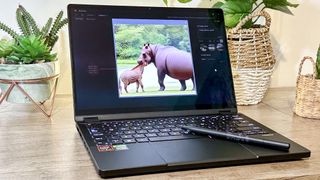
Design
Measuring 11.7 x 8.2 x 0.7 inches inches and weighing 3 pounds ensures the ProArt PX13 is a great travel laptop. While it's not as thin and light as the 13-inch MacBook Air M3, it's easy to carry from room to room and not a hassle to throw in a backpack to take with you to work.
Display
One of the main selling points of this laptop is its 13.3-inch 2.8K OLED panel, and it delivers both in our own hands-on testing and in our performance testing lab, achieving bright brights, deep darks and beautiful contrasts between light and shadow. A good OLED panel makes everything you do on it look better, and this laptop is no exception.
Performance
The AMD Ryzen AI 9 HX 370 in our Asus ProArt PX13 ensure that this thin-and-light laptop doesn't straggle when it comes time to work. And paired with the RTX 4070 and 32GB of RAM, this laptop can tear through big video editing projects and even play the latest and greatest games at high settings.
Battery life
In our battery test the Asus ProArt PX13 lasted for 9 hours and 28 minutes, which in a Snapdragon world isn't the best. It's acceptable and not a huge hassle if you don't plan to carry it around for a full day, but if you do it's kind of a bummer that you need to bring a charger with you or else risk running out of juice at a key moment.
Read the full review: Asus ProArt PX13
The best MacBook Pro alternative









Specifications
Reasons to buy
Reasons to avoid
| Test | Notes | How it stacks up |
|---|---|---|
| Battery life | 9:32 tested battery life | ★★★☆☆ |
| Performance | Great for intense creative workloads | ★★★★☆ |
| Display | A mindblowing 4K OLED touchscreen display | ★★★★★ |
| Design | Beautifully restrained aluminum construction | ★★★★★ |
What you need to know
The Asus ProArt P16 takes the familiar aluminum unibody enclosure of the ROG Zephyrus G16, classes it up a little and repurposes it for creators. It sounds like a small change, but the big updates on display here make it a true masterpiece of a portable creation station.
That 4K OLED display is super crispy and color accurate for crucial edits, the combination of AMD Ryzen AI 9 and RTX 4070 power through any and all tasks you throw at it, and the super responsive touch screen + DialPad control give you the options to make the most finite of changes to your creations.
Buy it if
✅You’re looking for a Windows 11 laptop for creativity: Whether you’re workload heavily involves Photoshop or Premiere Pro, or if you have a passion for music creation in Pro Tools, the sheer performance potential of this machine will keep up with any demands.
✅ You want confidence in the color of your work: Not every OLED display is the same. They can look amazing, but not be calibrated for accuracy. Every ProArt P16 is color calibrated so you can be sure that what you’re working on is true to what it will look like in real-life. Plus that display is simply gorgeous.
✅ You want a laptop you’re proud to whip out in public: A lot of laptops with dedicated GPUs can look a bit garish. The ProArt P16 is very demure and very mindful with its sleek aluminum shell, stellar keyboard and responsive touchpad with DialPad to dial into your creativity.
Don't buy it if
❌ You value battery life highly: For the general day-to-day, the stamina is OK. But any additional pressure like RAW Photoshop editing will drain it fast.
❌ You need lightning fast loading speeds: The SSD loading times in here aren’t overtly bad, but there are far faster options out there for transferring dense files — like the MacBook Pro.
The bottom line
💻 The Asus ProArt P16 is easily one of the best creator laptops you can buy — packing stellar performance, a fantastic display, great ergonomics and AI smarts into a carefully considered and sexy chassis.
The deep dive
Read the deep dive ▼
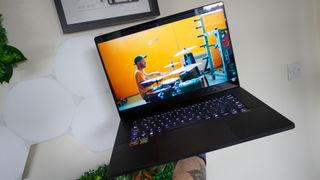
Design
The ProArt P16 feels unmistakably luxurious with its aluminum construction. It copies some of the ROG Zephyrus G16’s homework, but in a good way — replacing that silver tone with a mean matte black finish. And at 13.9 x 9.7 x 0.7 inches with a weight of 4.1 pounds, it manages to shave a bit of weight off the M3 Max MacBook Pro too.
Display
Opening up the ProArt P16 will reveal its mouthwatering 16-inch 4K OLED screen. It may only run at 60Hz, but for the creative pro, you just need super crispy detail and color you can trust, which this absolutely delivers on. Not only that, but the 16:10 aspect ratio is great for productivity, and that vividness alongside the amazing contrast makes this a fantastic binge watching display.
Performance
This laptop is a monster — packing AMD Ryzen AI 9 HX 370 combined with RTX 4070 GPU. Not only can it crush graphics-intensive creative tasks in a time that would make any MacBook Pro blush, but it’s also great for gaming too. Pair that with a ton of RAM, and you won’t see one iota of slowdown no matter what you do.
Battery life
In regular day-to-day use, the ProArt P16 does OK with over 9 hours in our battery test. But you’re probably more bothered about putting it under prosumer strain, at which point it does stumble slightly. If you plan to tax it with 4K video edits and the like, make sure you keep that charger with you.
Read the full review: Asus ProArt P16
The best MacBook Pro






Specifications
Reasons to buy
Reasons to avoid
| Test | Notes | How it stacks up |
|---|---|---|
| Battery life | 18:31 tested battery life | ★★★★★ |
| Performance | Great for video editing | ★★★★☆ |
| Display | Gorgeous mini-LED display | ★★★★★ |
| Design | Premium, durable design | ★★★★★ |
What you need to know
The 14-inch MacBook Pro with the M4 chip is one of the most powerful laptops we’ve yet tested, which is all the more impressive when you consider its svelte 3.4-pound chassis slips into a backpack with ease.
Of course, that's no surprise given that the company has been iterating on this design for years. The addition of an M4 chip under the hood takes the 14-inch MacBook Pro to new heights, making it the best MacBook Pro for most folks thanks to its unbeatable combo of size, performance and price.
Buy it if
✅ You need to edit videos on the go: And I'm not talking iMovie clips, either - I'm talking about working with Final Cut and Adobe Premiere to edit videos while you're away from desk. The M4 chip is built for this kind of work, and it will serve you well.
✅ You plan to work outside often: The M4 MacBook Pro is the first to come with the optional nano-texture glass coating, which costs $150 extra but helps stop glare from bright light-which is great when you work outdoors a lot.
✅ You want a MacBook that'll last for years: M4 MacBooks are still (barely) viable, so it stands to reason that M4-driven notebooks could potentially last you 5-10 years. This could help justify the admittedly high initial price.
Don't buy it if
❌ Gaming is important: The M4 MacBook Pro runs Mac-compatible games pretty well, but it's not the best gaming laptop for the money. If you care about gaming performance, go with one of the best gaming laptops instead.
❌ You own a MacBook Pro M3: The M4 MacBook Pro is more capable than its predecessor, but not by much. If you already own a recent MacBook Pro and you're not craving the nano-texture coating, there's no reason to rush out and upgrade.
The bottom line
💻 The MacBook Pro 14-inch M4 retains the same fetching design and gorgeous mini-LED display as its predecessors while delivering unprecedented speed and power efficiency. If you want a portable Mac more powerful than a MacBook Air but can't afford the extra expense or weight of a 16-inch MacBook Pro M4, this is the best MacBook Pro for you.
The deep dive
Read the deep dive ▼
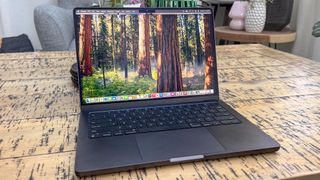
Design
The MacBook Pro M4 measures 12.31 x 8.71 x 0.61 inches and weighs roughly 3.4 pounds. That's nearly a pound heavier than feather-light ultraportables like the Dell XPS 13 and MacBook Air, but still pretty easy for most folks to carry for hours.
Display
The 14.2-inch Liquid Retina Display (3,024 x 1,964 pixels) on the MacBook Pro M4 looks just as good as it did on previous models, and the 120Hz refresh rate can help make scrolling feel smoother and let some games run at high framerates. Admittedly some people don't like the notch that hangs down from the top bezel, which conceals the camera equipment, but I find that you quickly stop noticing it once you get used to it.
Performance
The MacBook Pro 14-inch M4 delivers killer performance for its size, and you'll have no trouble blazing through basic productivity tasks and light work. More demanding tasks like video editing or crunching code can push the M4 to its limit, making this a great laptop if you want something powerful that's not a back-breaking 16-inch M4 Pro machine.
Battery life
The 14-inch MacBook Pro M4 lasted roughly 18 hours and 31 minutes in our in-house battery tests, which is remarkable performance that ensures you don't need to worry about plugging in when you're on the go.
While it's not the longest-lasting MacBook on this list, the 14-inch MacBook Pro M4 lasts hours longer than most competing laptops, meaning you should rarely need to lug the charger with you anywhere.
Read the full review: MacBook Pro 14-inch M4
Also tested
We test and review dozens of laptops every year, and just because they don't all make this list doesn't mean they aren't good machines.
No, there are loads of great laptops that don't quite achieve the level of excellence needed to lead the pack. But they're still great machines, and they're worth considering if you're looking for a specific feature or another laptop you want isn't available.
Below we've gathered all the great laptops we've tested which don't quite make this list, but are still good alternatives well worth considering if they meet your unique needs, or if you can't find your first choice on sale.
Asus Zenbook Duo (★★★★☆)
The Asus Zenbook Duo is one of the best dual-screen laptops you can buy because it feels sturdy and usable and thus less of a gimmick, and more of a real recommendation. From it's impressive value for money to the versatility of how you can use this, you will more than get your money's worth.
Read the full Asus Zenbook Duo review.
Microsoft Surface Laptop 7 (★★★★☆)
The Microsoft Surface Laptop 7 ($999 to start) is the first Surface Laptop to ship with a Snapdragon CPU inside, and the extra power and battery life it affords make this the best Surface Laptop yet. Good battery life and performance, along with a comfy keyboard and Wi-Fi 7 support, make this a great ultraportable for getting work done.
Read the full Microsoft Surface Laptop 7 review.
Battery benchmarks: comparison
We run every laptop we review through a series of battery tests to see how long it actually lasts on a full charge, which is one of the key deciding factors for most people when buying a laptop. You want to know about how long a laptop will actually last on a full charge so you know when to carry a charger with you, and when you're safe to leave it at home.
Note that these tests do not reflect real-world use patterns since we have to set every laptop to the same settings in order to do fair comparisons. Thus, while the times listed here are accurate and useful as a comparison point, your own experience with a laptop's battery life will likely vary quite a bit.
This is because when we run our battery test we set the laptop's display to 150 nits of brightness and have it endlessly browse the web via Wi-Fi until it dies. However, when you use your laptop you're likely adjusting brightness on the fly, doing all sorts of different tasks while perhaps listening to music or watching a video at the same time, and generally putting the machine through more of a workout than it gets in our test.
So while I stand by our testing and the battery life results we compare in the chart below, I want to be clear that your own experience will vary!
| Laptop | Battery life (tested) |
| Acer Aspire Go 15 | 10:15 |
| Dell XPS 13 (2024) | 19:41 |
| MacBook Pro 14-inch (M4) | 18:31 |
| MacBook Pro 16-inch (M4 Pro) | 20:46 |
| MacBook Pro 13-inch (M2, 2022) | 18:20 |
| MacBook Air 15-inch M2 | 14:59 |
| Lenovo Slim 7 | 10:10 |
| Lenovo Flex 5i Chromebook Plus | 7:36 |
| M1 MacBook Air | 14:41 |
| Asus ProArt P16 | 9:32 |
| Framework Laptop | 10:17 |
| Samsung Galaxy Book 4 Ultra | 13:19 |
| Microsoft Surface Laptop 7 | 15:44 |
| Alienware m15 R4 | 4:01 |
| Acer Chromebook Spin 713 | 11:54 |
How to choose the best laptop for you
What kind of power do you want? If you only need something basic for surfing the web, consider a Chromebook or a cheap Windows laptop with an Intel Core i3 processor and 4GB of RAM, because that's the minimum you should expect from a modern laptop. If you want something that feels speedy and can handle more than basic writing and web browsing, look for beefier laptops with at least an Intel Core i5 CPU from the past few years, 8 to 16GB of RAM and a 256GB to 512GB SSD for storage.
What kind of games do you want to play? Most laptops feature integrated graphics chipsets that are built into their CPU, which usually struggle to run demanding modern games but can often handle old or less graphically-demanding games. But if want to play the latest and greatest games on your portable PC you'll want a dedicated gaming laptop, because they come with more powerful discrete laptop graphics cards, more RAM, better cooling systems and other advancements designed to make them decent gaming machines. Of course, you have to make compromises when buying a gaming laptop that you don't have to make when buying one of the best gaming PCs, since your laptop needs a beefy battery and enough room to be able to discharge heat effectively without cooking its innards.
How big of a laptop do you want? Think about how often you might carry this laptop around. Machines such as the Dell XPS 13 and MacBook Air are remarkably light and slim, but their 13-inch screens are on the small side. You can get a larger 15-inch display on a premium ultraportable like the XPS 15 and still not have to worry about weight too much, but once you start getting up into the realm of 16-inch to 18-inch screens, expect your laptop to weigh at least 3-5 pounds. As mentioned above gaming laptops are almost always several pounds heavier than thin-and-light ultraportables because they need more room for beefier components, but they offer big power in exchange.
Do you want Chrome, macOS, or Windows? Windows is the most common operating system, while macOS is more ideal for folks already tied into Apple's ecosystem. ChromeOS is Google's minimal operating system, which has the advantage of being decent and cheap but the disadvantage of requiring an Internet connection to take advantage of its full features.
So if you don't think you'll be online often, a Chromebook is a poor choice and you should go with Windows or macOS instead. On the other hand, if you just need a low-powered laptop or tablet for browsing the web, writing emails and watching videos, ChromeOS will do you just fine.
Whichever system you decide on, you may also want to consider investing in the best mouse and best keyboard for your needs so you can have some more ergonomic options for getting work done on your new laptop. I also recommend getting yourself an affordable laptop stand, as a $45 stand revolutionized the way I work on the go.
Frequently asked questions
How do I find the best laptop deals?
We've scoured the internet and given you the best deals on our favorite laptops just above, but we know they're not going to be the best options for everyone! If you're shopping around for something more suited to your tastes, here's how our team go about finding stellar savings.
First things first, establish what you're looking to buy and set a budget. It's easy to watch costs spiral and before you know it, you've dropped thousands of dollars on additional power and features you may not need. Figuring out what you want to do with your laptop and how much money you're comfortable spending is the best option. For example, saying "I want a good gaming laptop for under $1,000" will net you a whole host of great budget-to-mid-range choices.
Second, retailers are going to work really hard to make its deals look super attractive with huge percentage discounts, but don't fall for it. We've already spotted numerous deals that have actually been cheaper in the past.
As a good sense check for this, take a look at downloading the Camelizer — a Chrome extension that can run an extensive historical price check on any Amazon product. With that line graph, you can see whether that Cyber Monday laptop deal is actually a deal.
And finally, within your choice, have a think about what particular features of a laptop matter to you. If you're someone who cares about screen real estate, the choice is obvious. But if you can really stretch the graphical capabilities of that silicon with your workload, think again.
Or maybe you want the vastly increased amount of app support and customization opportunities of Windows 11, which will also net you better value for money than the MacBooks, but also lacks the simplicity of macOS. Just take a breather, think about what things matter — the software, the keyboard being good to type on, etc — and make the best judgement for you.
What kind of laptop should I buy?
Laptops are so diverse now that it's impossible to know what you should buy without knowing your unique needs, but you can ask yourself some questions to help narrow down your options.
Where will you use this laptop? If you need something to carry to work or school you'll want something that's light and lasts at least 10+ hours on a charge, like the MacBook Air or Acer Swift 5.
What do you want to do with it? If you care about playing games, making games or doing video work you'll want a laptop with a discrete graphics card like the Samsung Galaxy Book3 Ultra. True gamers will want to consider the best gaming laptops as well, but be warned most are heavy and barely last a few hours on a full battery.
Which operating system fits your life best? MacBooks are best if you're going to be working with others on Macs, and they've got great integration with your iPhone and iPad. Windows laptops are also great, and much easier than MacBooks to integrate into an office or school full of Windows machines. But don't overlook Chromebooks, as these ChromeOS-powered laptops are typically cheaper than the competition yet are perfectly fine for browsing the web, basic productivity work and even light gaming.
How much RAM do I need?
This can be tricky to know because it's not like storage, where you can sort of predict how much you'll store on the laptop and plan accordingly. RAM is the memory your laptop moves files in and out of in real time while you're using them, so having more of it improves game performance, multitasking speed and generally makes everything feel snappier.
In general, I recommend you get a laptop with at least 8MB of RAM if you don't want it to feel sluggish. If you plan to do a lot of multitasking or running demanding apps and games, try for at least 16GB of RAM.
If you plan to play a lot of fast-paced modern games it's not a bad idea to get a laptop with as much RAM as you can afford, as much as 32MB or more.
How we tested these laptops
How we test the best laptops
In our never-ending quest to find the best laptops we put every computer we test through a barrage of synthetic and real-world tests to benchmark how well it performs compared to the manufacturer's claims, and compare how good it is relative to the competition.
These tests include, but are not limited to: measuring the average brightness and color quality of each laptop's display using our in-house colorimeter, using a heat gun to measure the heat generated by the laptop after 15 minutes of strenuous work, and using a mix of real-world and synthetic benchmarks to test how well a laptop performs at various day-to-day tasks. We run all laptops through the Geekbench CPU performance benchmark tests as well as various 3DMark tests to measure graphics capabilities. We also run a file transfer test to measure how fast a machine's hard drive is, a video transcoding test to gauge how well a laptop can cut video and a custom battery test that has the machine browse the internet over Wi-Fi until it runs out of juice.
We also run every laptop we test through a basic game test using Sid Meier's Civilization VI: Gathering Storm to gauge how good it is at running games compared to other laptops. We use this old game because it runs on a wide variety of laptops across different prices, sizes and operating systems, so it's great for comparing performance.
Of course when testing dedicated gaming laptops we run benchmarks for many more demanding and popular games, including Assassin's Creed Valhalla, Cyberpunk 2077 and Red Dead Redemption 2. For more information on our testing process, check out our guide to how we test.

Alex Wawro is a lifelong journalist who's spent over a decade covering tech, games and entertainment. He helps oversee the computing department at Tom's Guide, which includes managing laptop coverage and reviewing many himself every year.
Sign up to get the BEST of Tom's Guide direct to your inbox.
Get instant access to breaking news, the hottest reviews, great deals and helpful tips.

Alex Wawro is a lifelong tech and games enthusiast with more than a decade of experience covering both for outlets like Game Developer, Black Hat, and PC World magazine. A lifelong PC builder, he currently serves as a senior editor at Tom's Guide covering all things computing, from laptops and desktops to keyboards and mice.
